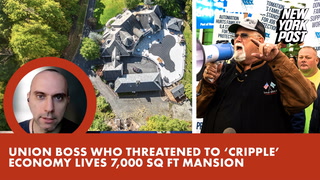In a world where the intersection of labor relations and economic stability can sway public sentiment and influence political landscapes, the recent revelations about a prominent union leader have sparked significant discourse. This union boss, known for his fiery rhetoric and unwavering commitment to workers’ rights, has made headlines not just for his advocacy but also for his striking residence—a sprawling 10-acre compound in New Jersey.
At first glance, this juxtaposition raises eyebrows. How does a figure who has threatened to “cripple” the economy in pursuit of labor rights reconcile his personal wealth with the struggles of the workers he represents? As we delve deeper into this narrative, it becomes imperative to explore both the complexities of his position and the broader implications for labor movements across the nation.
The union leader in question has long positioned himself as a champion for the working class, often demanding better wages and working conditions. His aggressive tactics, including striking and public demonstrations, have garnered both admiration and criticism. Supporters argue that such measures are necessary in an era where corporate profits continue to soar while worker wages stagnate. According to a 2022 study by the Economic Policy Institute, real wages for the bottom 90% of workers have grown at a mere 0.3% annually since 1979, highlighting the urgent need for reform.
However, his luxurious lifestyle raises questions about accountability and authenticity. Living in a lavish estate, complete with manicured lawns and expansive facilities, can create a perception of disconnect from the very struggles he espouses to alleviate. Critics suggest that this disparity undermines his credibility. In a recent interview, labor expert Dr. Sarah Thompson noted, “When leaders of labor movements appear out of touch with the everyday realities of their constituents, it can breed skepticism and diminish trust.”
Moreover, the leader’s threats to disrupt the economy evoke fears not only among business owners but also among ordinary citizens who rely on stable economic conditions for their livelihoods. The ripple effects of a strike or labor disruption can lead to job losses, increased prices, and economic uncertainty. A report from the Bureau of Labor Statistics indicates that strikes have a substantial impact on local economies, often leading to decreased consumer spending and disruptions in supply chains.
This scenario raises a critical question: How can union leaders effectively advocate for workers while maintaining a relatable and trustworthy image? A balanced approach may involve transparent communication about their own financial realities, as well as a commitment to grassroots initiatives that directly benefit the workers they represent. Engaging in community development projects or supporting local businesses could bridge the gap between their personal wealth and the economic struggles of their members.
Furthermore, the ongoing evolution of labor relations in the digital age cannot be overlooked. With the rise of remote work and the gig economy, the landscape of labor advocacy is shifting. Unions are adapting their strategies to address the unique challenges faced by these workers, often leading to innovative solutions that prioritize flexibility and worker autonomy. As such, union leaders must remain attuned to these changes, ensuring their approaches resonate with a diverse workforce.
In conclusion, the story of this union boss and his opulent New Jersey estate serves as a microcosm of the broader challenges facing labor movements today. While the pursuit of workers’ rights remains paramount, the need for authenticity and relatability in leadership is equally crucial. As labor unions continue to navigate an ever-evolving economic landscape, the balance between advocacy and accountability will determine their effectiveness in championing the rights of workers across the nation. The dialogue surrounding these issues is essential, not only for union leaders but for all stakeholders invested in the future of work.

